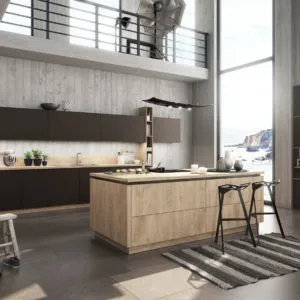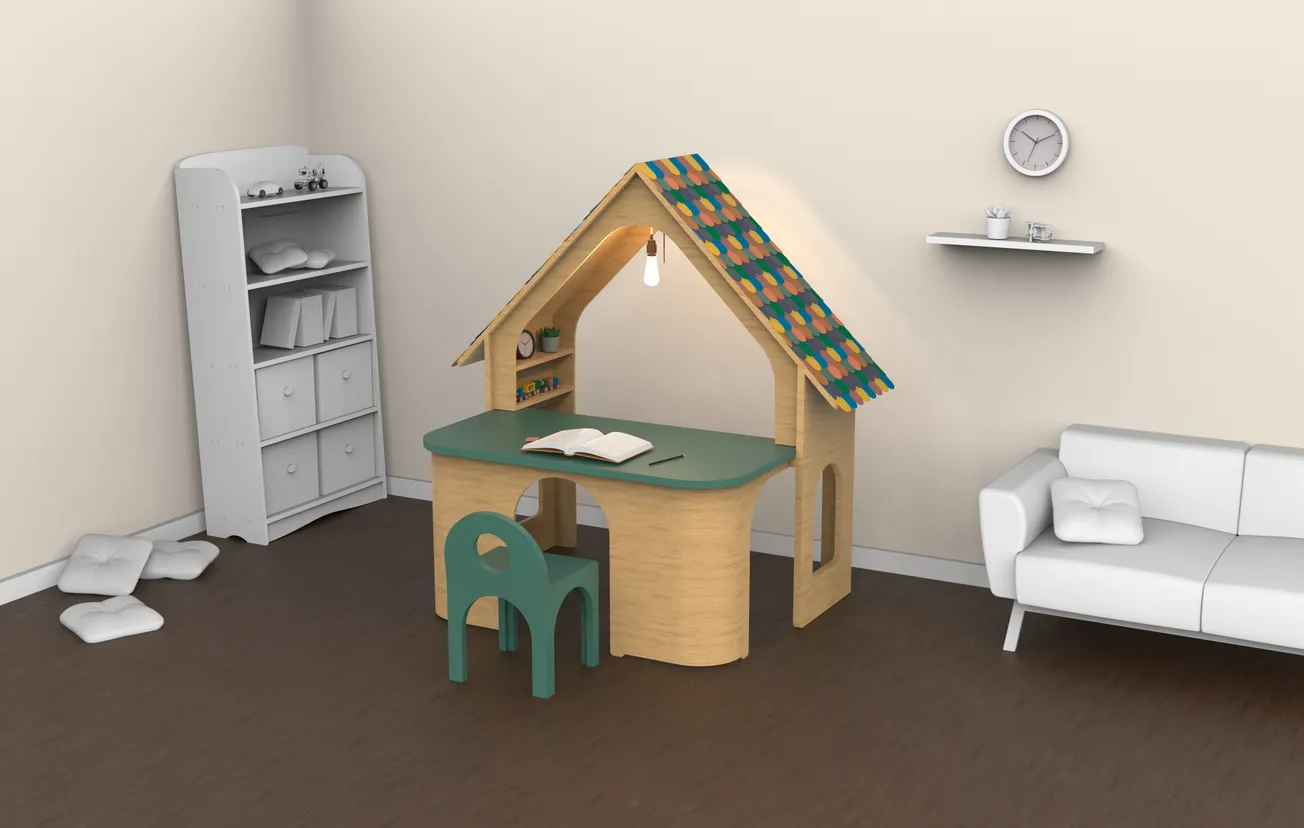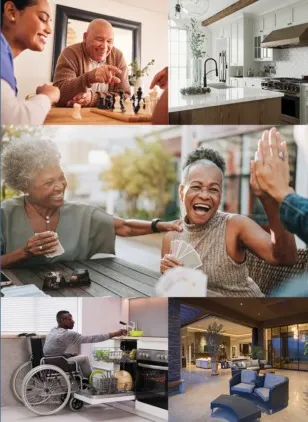Table of Contents
Bauformat USA brings European trends to North America
 In Germany, the analogy is strong between the automotive industry—often considered the most vivid expression of what a culture is about in a time—and the kitchen industry. In both, the end product not only has to function, but it has to look great, be efficient to manufacture with regular modifications and give pleasure to the operator.
In Germany, the analogy is strong between the automotive industry—often considered the most vivid expression of what a culture is about in a time—and the kitchen industry. In both, the end product not only has to function, but it has to look great, be efficient to manufacture with regular modifications and give pleasure to the operator.
The Baumann Group, one of the top 10 kitchen manufacturers in Germany, carries that analogy into leading-edge kitchen concepts sold in more than 60 countries worldwide. With just over 645,000 square feet of state-of-the-art panel-processing power between two facilities (located in Löhne and Burg) and partnerships with leading hardware and accessories manufacturers, the company builds furniture-quality performance kitchens.
Making slight adjustments to positioning, it’s brought three brands of “The Kitchen Family” to the North American market.
On this side of the Atlantic, Bauformat occupies the mid-to-high residential kitchen segment and includes a premium custom line called Baulux. Burger Kitchens serves modern multi-unit developments. Badea is dedicated to bathroom spaces.
“Our company has done successful business in Europe for the past 100 years, and the North American market was different and exotic for us,” said Natasha Mnat, branding strategy and design manager for Bauformat USA. “So we researched the market and relaunched the Bauformat brand for American consumers. There are many different competitors in North America, but the trends run 5 to 10 years behind the European styles. Even with modern materials, we noticed most people stick to the old styles. We saw an opportunity to bring in our newest high-end kitchen innovations and expedite the arrival of European trends.”
Getting from There to Here
Bauformat’s presence in North America marks an arrival in concept as much as product.
In North America, the most popular kitchen and bath style currently and in recent history is transitional. To meet that demand, much of the progress in the segment is aimed at using modern materials and methods to build a bridge to traditional kitchen archetypes. For cabinetry, developments focus mainly on visual and tactile fidelity of classic woodgrains and replicating five-piece door construction—with some high-gloss neutral to push the boundaries. Work surfaces work hard at emulating natural or composite stone. The success in reproducing these kitchen standbys—but with the increased durability, performance and precision of engineered materials—is unquestionable.
However, while Bauformat has the technology to imitate classic kitchen finishes, the company uses engineered materials to surprise and delight—designing for aesthetics that regularly go beyond what can be achieved with natural materials.
“The Bauteam designers believe that the time of a kitchen as a ‘punishment place’ for the woman to cook meals and wash dishes is over. Nowadays, it is a place to gather. Kitchens must be ergonomically correct, functional, easily maintained and look like beautiful furniture,” Mnat said.
“To this end, our entire collection changes every year to include new innovations in material and hardware. We offer HPL, foils, glass, exotic woods, lacquers and deeply textured TFL. But also a lot of door fronts from materials most people can’t imagine will be used for kitchen doors, like porcelain, metal, leather and fishskin lacquered any color of the rainbow.”


Other interesting surfaces in Bauformat’s collection include:
– Textured HPL and TFL made using a two-step process with two layers of lamination to achieve customizable, deep, natural textures.
– A ceramic surface laminated to particleboard with aluminum back available in a black TFL finish. The material can be used to build a block design incorporating a hidden induction cooktop for a seamless, solid look.
– A metallic shimmering front panel called Enigma developed exclusively in-house at Baumann Group.
– “Fenix” fronts by Arpa Industriale made with a multilayered coating of nanoparticles, which makes the material fingerprint, water and heat resistant. The material is also “self-healing,” so micro-scratches on the surface are reparable with heat.
Bauformat’s offerings encompasses 10 price points and myriad options—including marine-grade plywood cabinet boxes for coastal customers. Kitchens are sold in North America through a select network of dealers, as well as architects, designers and developers.

“Our end customers like the modern materials because of the durability but also the affordability and integrity. For example, if an installer makes a mistake, a panel can be replaced much faster and easier than if it was a book-matched veneer door,” Mnat said. “It allows us to offer excellent customer service and a lifetime warranty.”
Putting it All Together
Production facilities for Bauformat employ 950 people and make 130,000 kitchens per year, 32 percent of which are exported. “Most of our Bauformat door fronts are made in house, with the exception of some of our exclusive Baulux doors, which we source from Italy and France,” Mnat said. “We try to be as independent as possible from outside suppliers to eliminate potential problems.”
Continual investment in robots, automatic storage and retrieval systems, material tracking and material handling—much of it from the Homag family—allows the Baumann Group to efficiently produce a wide, customizable and frequently changing product offering.
“It is very German in that everything is automatic. This minimizes human error and allows us to manufacture a lot of kitchens quickly and with premium quality,” Mnat said. “There are not many people in the factory. In Germany, they’re mostly doing quality control and adding special details that require a craftsperson’s touch.”
If necessary, Bauformat can deliver a finished kitchen to North America in 28 days.
The Baulux line is fully customizable. The basic Bauformat kitchen line is built on a cube system, which utilizes standard dimensions for building kitchen cabinet boxes and fronts, while allowing for personalization of carcass, substrate and surface materials.
 “Many of our production lines are very flexible in terms of the materials we are able to process on them,” Mnat said. “We also have specialty processes. For example, we offer lacquer doors where the front and back are coated and the edges edgebanded. It is a nice, affordable option. But we have another door, lacquered on all profiles, and for that particular process we have a special segment in the factory and special equipment, which actually polishes each edge of the door.”
“Many of our production lines are very flexible in terms of the materials we are able to process on them,” Mnat said. “We also have specialty processes. For example, we offer lacquer doors where the front and back are coated and the edges edgebanded. It is a nice, affordable option. But we have another door, lacquered on all profiles, and for that particular process we have a special segment in the factory and special equipment, which actually polishes each edge of the door.”
The other differentiator for Bauformat USA is maximizing available functional hardware and accessory technologies, which again echo amenities found in automotive design. Touchless sensors lift doors and open drawers. Stacked shelving inside drawers recedes with automated movement at the push of a button to reveal storage inserts. Integrated LED strip or puck lighting adds big convenience to small spaces.
“It is not enough for the kitchens to look great. They need to be functional. Sometimes, we say our intention is to ‘bring the kitchen to you.’ We use a lot of Blum hardware, sometimes even collaborating with them to develop specific solutions,” Mnat said. “Blum and Häfele are leaders in hardware. We also offer organization inserts from Kesseböhmer.”
Gone are the days when automation meant trading personalization for efficiency.
“Gone are the days when kitchens looked like kitchens,” Mnat said. “What counts today is individuality. When we design with Bauformat, we are able to make kitchens our clients want while eliminating all the unnecessary charges for customization.”









